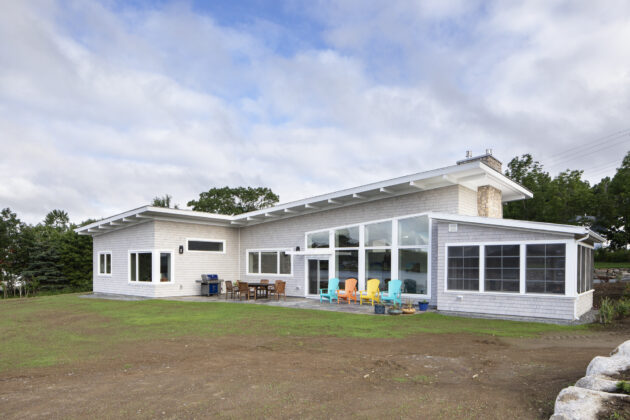

Photo courtesy of Passive Design Solutions.
The Canadian housing market is on the verge of a building boom. Surges in population, combined with a restricted housing supply are creating the conditions for a vibrant building market. However, in addition to meeting this demand, builders are increasingly tasked with ensuring that these new homes comply with more stringent building codes as well as the industry’s climate targets. This is an ambitious task, as it not only requires builders to adopt new materials and building strategies, but also new supply chains and the effective retrofitting of older properties.
The Canadian construction industry is uniquely poised to assert itself as a leader in high-performance construction for cold climates. The present housing situation is ripe for the opportunity to use novel approaches and model a greener future for all. Net Zero building is one of the dominant approaches in sustainable construction right now and will undoubtedly become more widespread in the near future as it brings together a reduction in energy consumption and renewable power generation.
Build strong bones
When it comes to building Net Zero homes, size matters. The more surface area and outside/inside corners your building has, the more opportunity there is for heat loss during the winter. Net Zero building is all about maximizing heat retention, and a compact build is the most effective way to achieve this.
Assemblies can make or break a home’s efficiency, so it is essential to ensure that they are airtight and well-insulated. Thermal bridging poses a risk of condensation, as well as heat loss in winter and heat gain in summer. Continuous insulation is effective at reducing and eliminating thermal bridging, making it a must for any Passive or Net Zero home. It is important to conduct a pre-drywall blower door test to verify airtightness and identify any potential issues before closing up and finishing the home.
Keep the end in site
While it is always important to tailor the design of your project to the opportunities and constraints of the site itself, it has an especially significant impact on construction of Net Zero homes. These buildings have a uniquely symbiotic relationship with their surrounding environment, using the natural features of their particular climates to their advantage.
For example, consider the impact of the vegetation surrounding a given site. Coniferous trees can provide cooling shade all year round, whereas deciduous trees provide shade during warmer months and allow more sunlight to come in during colder months. Being strategic about positioning the building in relation to the pre-existing vegetation can have a noticeable impact on energy consumption and heat retention.
Understanding the location’s climate and orienting the build to maximize (or minimize) heat and light from the sun can provide both environmental and aesthetic benefits to the home. Similarly, opting for strategically sized, well-placed windows can provide natural temperature regulation all year round.
Establishing the infrastructure for solar PV from the beginning is also a crucial step in optimizing performance and planning for Net Zero. Either rooftop or ground-mounted solar PV (depending on location) requires planning the location and size of the solar system as part of the design and build. Even if solar PV will not be installed as part of the initial build, creating the infrastructure for an upgrade is crucial to ensuring improved efficiency down the road.
Don’t cut corners
Achieving Passive House levels of airtightness is another key aspect of Net Zero home design. Passive Houses dramatically reduces the need for mechanical heating and cooling, instead creating a comfortable living environment through the strategic use of windows, insulation, and other structural features.
Generally, it is suggested to work with a high-performance envelope specialist to achieve optimal results, as Passive House construction requires extensive technical expertise. The primary principle behind this approach is to maximize heat retention through high-performance windows, doors, and assemblies, orienting for passive solar heating, and using high efficiency mechanical systems to keep energy costs low and comfort high.
Achieving this balance requires close attention to the unique orientation, climate, geometry, and construction assemblies of the build. Minimizing or eliminating exterior venting fans, installing a high-efficiency heat recovery ventilator, avoiding single or double hung windows and opting instead for triple pane, casement, awning, or tilt and turn windows are all helpful best-practices in Net Zero design.
Make the most out of your investment
Once you have upgraded the building envelope, it’s essential to adopt mechanical heating and cooling systems that capitalize on the efficiency of its architecture.
For primary heating and cooling, high efficiency heat pumps should be your go-to-option. These all-electric systems are both inexpensive and efficient, minimizing energy costs for the consumer while maintaining a higher standard of comfort. Domestic hot water is the next largest demand for energy in a home after heating and cooling and especially in larger households with higher demand, a hybrid heat pump water system is typically the most convenient and cost-effective option.
These practices are not hard-and-fast rules, but flexible guidelines that should be adopted and adapted based on the particular logistics of your site, project, and client. Deviating from these practices, however, may have dramatic impacts on both construction costs and the size of the home’s solar array, so conducting due diligence by having an experienced consultant model the project and various scenarios beforehand is important. They can optimize your design based on your particular budget and the needs and constraints of the project, allowing you to consistently achieve your building goals.
_________________________________________________________________________________________
 Mike Anderson, MArch, BSc is the CEO and Design Leader of Passive Design Solutions, a Canadian design firm specializing in Net-Zero ready building design. In addition to building single-family homes, the team has worked closely with a number of non-profit and community housing groups to design low-income community housing projects that achieve exceptional net-zero performance. Mike has worked on over 300 Net Zero Ready projects throughout North America over 10 years, establishing him as one of the nation’s foremost passive house experts.
Mike Anderson, MArch, BSc is the CEO and Design Leader of Passive Design Solutions, a Canadian design firm specializing in Net-Zero ready building design. In addition to building single-family homes, the team has worked closely with a number of non-profit and community housing groups to design low-income community housing projects that achieve exceptional net-zero performance. Mike has worked on over 300 Net Zero Ready projects throughout North America over 10 years, establishing him as one of the nation’s foremost passive house experts.
Advertisement
Print this page

I agree with the article, but I would like to point out that a high-performance heat pump (cold climate central heat pump at least) are not remotely inexpensive, and the same with hybrid heat pump water heaters. Again, I support these practices to incorporate in a home, but inexpensive is not an adjective to describe building to this standard.